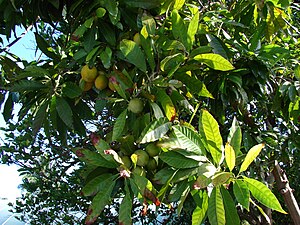Pouteria campechiana
| Pouteria campechiana | ||||||||||||
|---|---|---|---|---|---|---|---|---|---|---|---|---|

Pouteria campechiana |
||||||||||||
| Systematics | ||||||||||||
|
||||||||||||
| Scientific name | ||||||||||||
| Pouteria campechiana | ||||||||||||
| ( Kunth ) Baehni |
Pouteria campechiana , as Canistel called, is a plant species within the family of sapotaceae (Sapotaceae). She comes from Central America . As a fruit tree , it is also cultivated in Asia and Africa. The fruits are eaten raw or processed.
description
Appearance and leaves
Pouteria campechiana is an evergreen tree that reaches a height of 5 to 10, rarely up to 20 meters and forms a slender crown. The gray-brown and longitudinally furrowed bark releases white latex when injured .
The alternate and urged arranged at the ends of the branches leaves are divided into petiole and leaf blade. The finely hairy petiole is 10 to 25, rarely up to 45 millimeters long. The thin, leathery, simple leaf blade is 10 to 35 centimeters long and 4 to 8 centimeters wide and lanceolate or obscure-lanceolate with a long wedge-shaped blade base, a short, extended tip and a smooth leaf margin. Both sides of the spreader are dark green and shiny.
Flowers and fruits
The flowers stand individually or in groups in the leaf axils of young twigs on 5 to 12 millimeter long, densely hairy stems. The fragrant flowers are hermaphroditic with a double flower envelope . The five overlapping, green sepals are egg-shaped to rounded, with a length of 4.5 to 11 millimeters and a width of 8 to 12 millimeters. The five or six greenish, cream-colored or whitish and silky-haired petals are fused into a 5 to 6, rarely up to 8 millimeter long corolla tube that ends in five or six corolla lobes.
With a length of 7.5 to 14 centimeters and a diameter of 2.5 to 11 centimeters, the round, broadly egg-shaped or spindle-shaped berries weighing up to 700 grams are indented at the attachment point of the fruit stalk and often have a short, drawn tip at the top. The sepals remain at the base of the berry. Unripe fruits give off a white, very sticky milky juice when wounded . The skin of ripe fruits is thin, tough, orange-yellow, often spotted brown, smooth, dull or slightly shiny. The orange-yellow pulp is somewhat fibrous, floury, dry and has a sweet, slightly aromatic taste. The one to five seeds are about 6.5 inches long and 2.5 inches wide, flattened ovoid or oval, pointed at one end, shiny red-brown with a wide, white hilum .
Pouteria campechiana flowers and fruit all year round.
Occurrence
The natural range of Pouteria campechiana is in southern Mexico, Belize , Guatemala , El Salvador , Costa Rica , Honduras, Nicaragua and Panama. This fruit tree is commonly grown in the West Indies , Central America, Florida , India , Sri Lanka, Indochina and Southeast Asia , and less often in East Africa and the Seychelles . Pouteria campechiana grows on poor and shallow soils in the frost-free climate of the tropics and subtropics and is insensitive to drought.
Systematics
The species Pouteria campechiana belongs to the genus Pouteria in the subfamily Chrysophylloideae within the family of the Sapotaceae .
This type was developed by Karl Sigismund Kunth 1819 as lucuma campechiana ( Basionym ) first described . Charles Baehni placed them in the genus Pouteria in 1942 .
use

The ripe fruits are eaten without peel as fruit or salted, peppered and drizzled with lemon juice. The pulp is used in baked goods, puddings, milkshakes, jams and ice cream. The fruits are nutritious, high in carbohydrates, proteins, and vitamins A, B and C.
In Central America, decoctions of the astringent bark are used as a medicine for fever and skin diseases.
The propagation is by seed, wherein the trees by grafting be grafted. The fruits are harvested when they have turned yellow. They are left to ripen for a few more days for consumption.
literature
- Bernd Nowak, Bettina Schulz: Pocket dictionary of tropical crops and their fruits . Quelle & Meyer, Wiebelsheim 2009, ISBN 978-3-494-01455-5 , p. 470 f .
- Flora of North America Editorial Committee (Ed.): Flora of North America North of Mexico . Volume 8: Magnoliophyta: Paeoniaceae to Ericaceae . Oxford University Press, New York / Oxford a. a. 2009, ISBN 978-0-19-534026-6 , pp. 245 (English).
Web links
- Pouteria campechiana. In: The Plant List. Retrieved March 20, 2012 .
Individual evidence
- ↑ German name after Nowak, Schulz: Pocket dictionary of tropical useful plants and their fruits. P. 470.
- ↑ a b Nowak, Schulz: Pocket dictionary of tropical useful plants and their fruits. P. 470.
- ^ A b Richard P. Wunderlin, R. David Whetstone: Pouteria campechiana in Flora of North America p. 245
- ^ Jules Janick, Robert E. Paull: The Encyclopedia of Fruit and Nuts. CABI International, 2008, ISBN 978-0-85199-638-7 , p. 835.
- ↑ a b c d e Nowak, Schulz: Pocket dictionary of tropical useful plants and their fruits. P. 471.
- ↑ a b c Pouteria campechiana. In: Germplasm Resources Information Network (GRIN). United States Department of Agriculture, accessed March 20, 2012 .
- ↑ Lucuma campechiana. In: Germplasm Resources Information Network (GRIN). United States Department of Agriculture, accessed March 20, 2012 .
